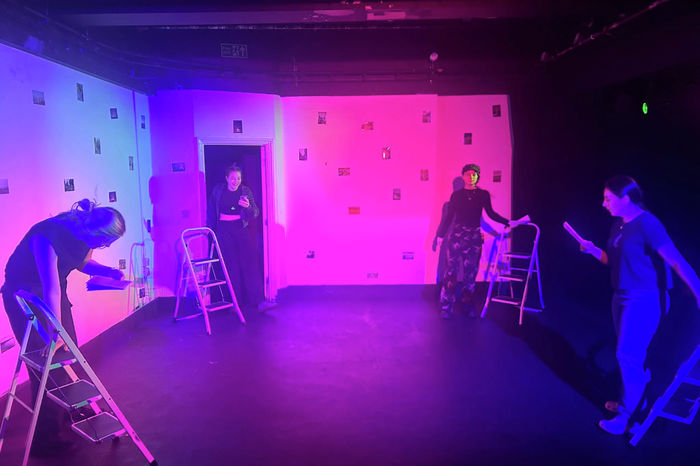Folie Circulaire is astonishingly chilling
This production exploring the inescapability of mental illness wondrously sucks the audience in

Folie Circulaire starts before the audience is in the room: a woman dressed in a white cotton smock, with blue lipstick and red circles of blush on her cheeks, sits like a doll, legs and arms stretched in front of her, at the back of the room. She feels uncanny – half porcelain, half-Victorian clown figure. A similarly dressed woman stands in front of the audience, facing away from us, slowly touching her neck and chin. One man stands opposite completing a similar action; a final figure, a man in deer antlers, whose outfit is a modern reconstruction of an Elizabethan silhouette, inevitably reminds one of Puck in A Midsummer Night’s Dream.
Sat surrounded by these figures it is difficult to feel like you haven’t walked into a dream in the style of Commedia Dell’arte featuring Victorian clowns. Unsettled and eerie, writer and director Martha Alexander effectively tells their audience from the moment they enter the room that they are in a waking nightmare, in the world of the uncanny. This play is not confined to a stage in front of you – it is meant to work its way off the stage, extend past its time limit, and wheedle its way into your mind.
“Lloyd Yorke is proficient in making these monologues feel as if they originated from the deep recesses of Antony’s mind”
Folie Circulaire translates as ‘Circular Insanity’, termed by French psychiatrist Jean-Perre Falret to refer to a patient who has suffered successive mental states of mania and depression (what we would refer to as bipolar disorder today). Folie Circulaire explores mental illness, its inescapability, and the sometimes enrapturing obsession with suffering through the analogy of religion and worship. The play depicts these struggles with self-hating cycles of depression and the egotistical highs of mania through the guise of the central character Antony, played by Harry Lloyd Yorke, trying to start a Catholic sect. He plans this with the “shadows” in his mind, who we gradually feel might be shadows of real people in his life.
A particular strength of the show is Martha Alexander’s beautiful writing – Antony hopes to “run to the peak to catch the sun basking in earliness”; he has the feeling that some outside force might “whitewash my conscious and imbue me to forget”. Lloyd Yorke is proficient in making these monologues feel as if they originated from the deep recesses of Antony’s mind rather than a rehearsed script. It would have been very easy for any of the actors to struggle or stumble over these dense, wordy, undulating monologues. But this didn’t happen – a particular achievement especially considering opening night nerves.
That said, the play is not for everyone. The themes are dark, and the language often works with a delicate interplay of religious terminology broken up by implications of shocking violence. Alexander creates a subversive meditation on the darkest desperate practices of the human mind in crisis. The play deals with self-harm, exploring this as a form of obsession, like religion. Antony’s self-harm “feels Messianic”. It splits up his experience of himself into a three, a trinity. He who does the action, the one who thinks it is okay, and the one who does not. Not only does this further themes of being split, of possessing contrasting perspectives that bring into the foreground the idea of bipolar disorder, but also, this harkens to the play’s repeated images of harm, injury and the body being split into pieces or destroyed as a form of sacrifice; Antony wants to be taught “by dissection”. Self-harm becomes a religious ritual one does to worship their pain. Pain for Antony is inescapable.
“The extreme changes in physicality keep the audience disorientated, lost, and overwhelmed”
Another strength of the play is its physical acting. The actors at various points felt like wild caged animals, flailing on the floor, sheep eating grass, monsters crawling out from under tables, people struggling to walk dragging their chairs across the floor with a horrible screeching noise. The extreme changes in physicality keep the audience disorientated, lost, and overwhelmed – on edge, even. I half always expected a jump scare, and felt too close to the uncanny figures surrounding the audience. The audience is forced to turn round, to see the drama we – like Antony– have become trapped in.
Moreover, the Pembroke Cellars’ lighting capabilities were pushed to their full extent. Lighting Designer Jasper Harris managed to seamlessly interweave blue, red, green, and yellow lights as well as singular stage lights and the house lights, all of which are used at various moments within the play. This effectively furthered the dream-like disorientated feeling, and linking to Antony’s unstable mental states, it mirrors the play’s indulgence in the obsession, uncanny, incomprehensible nature of a suffering mind.
As I mentioned before, despite its uniqueness and quality, this show is not going to be for every audience member. If you do not like the absurd, the strange, and the darkly comic, and find it difficult to indulge yourself fully in shows that work in this arena, then this awe-striking production is likely not for you. The audience, like the shadows in Antony’s mind, must be willing to become worshippers. We too become enraptured by Antony’s desperate attempts to voice a pain that might be indescribable.
‘Folie Circulaire’ is showing at Pembroke New Cellars from Tuesday 26th until Saturday 30th November, at 7pm.
 News / Uni offers students £55k in payouts31 October 2025
News / Uni offers students £55k in payouts31 October 2025 News / Uni error forces deeper spending cuts31 October 2025
News / Uni error forces deeper spending cuts31 October 2025 News / Students allowed to use AI, says new uni guidance31 October 2025
News / Students allowed to use AI, says new uni guidance31 October 2025 News / Students launch women’s society excluding trans women31 October 2025
News / Students launch women’s society excluding trans women31 October 2025 News / College rowing captains narrowly vote to exclude trans women31 October 2025
News / College rowing captains narrowly vote to exclude trans women31 October 2025










